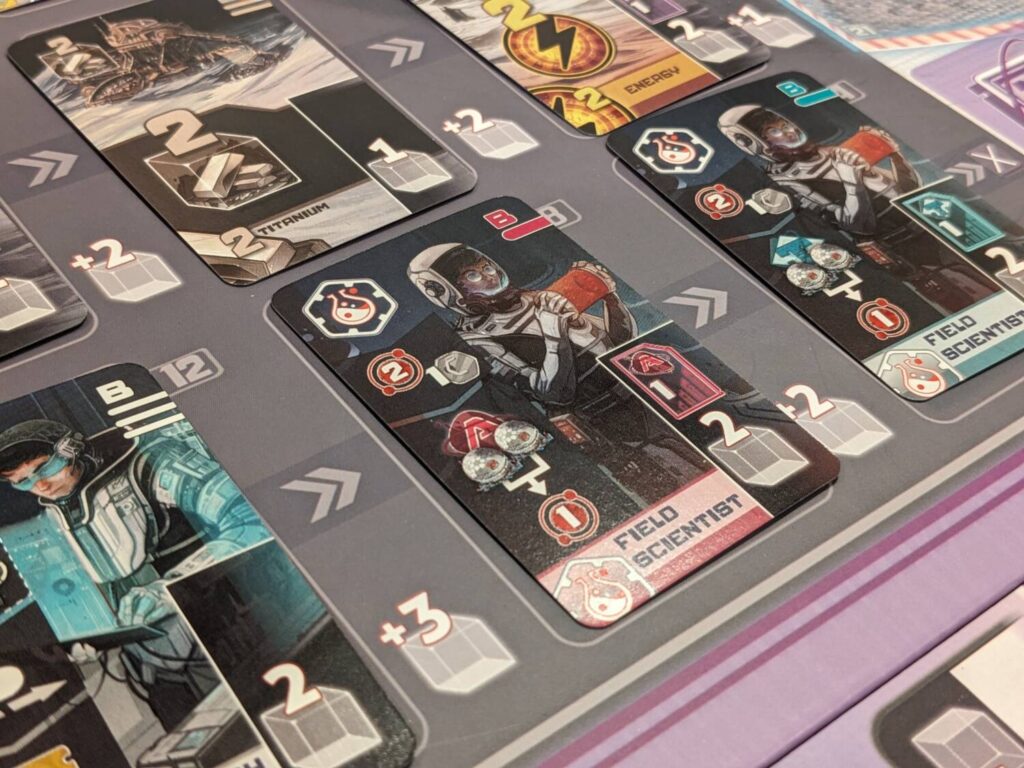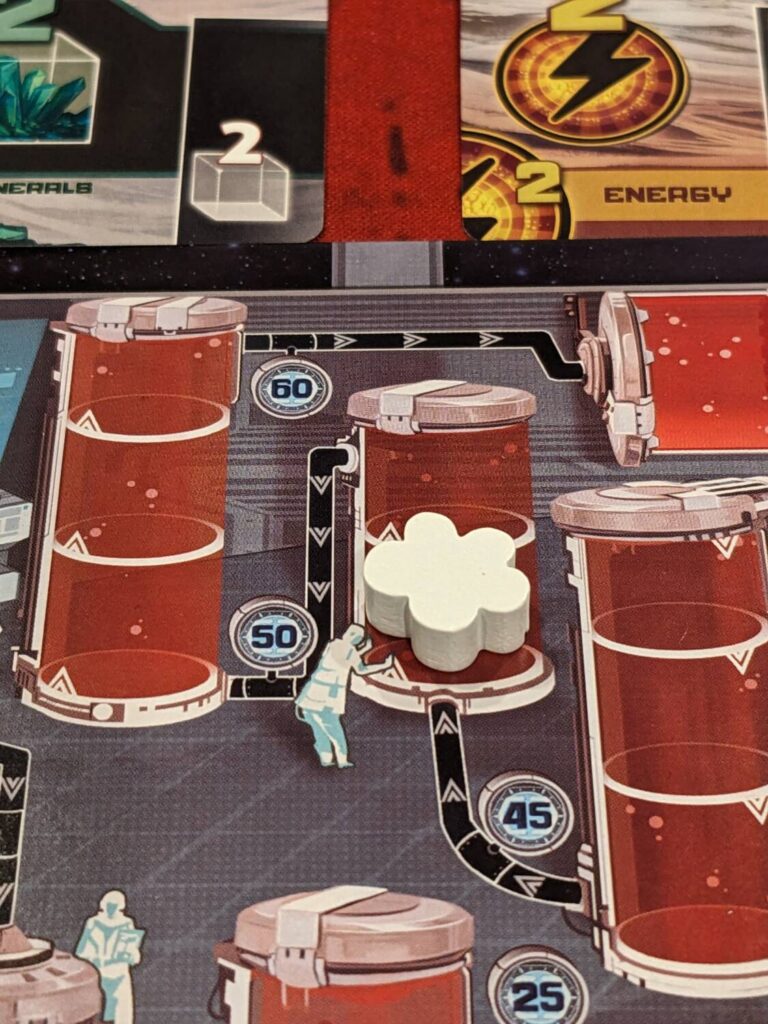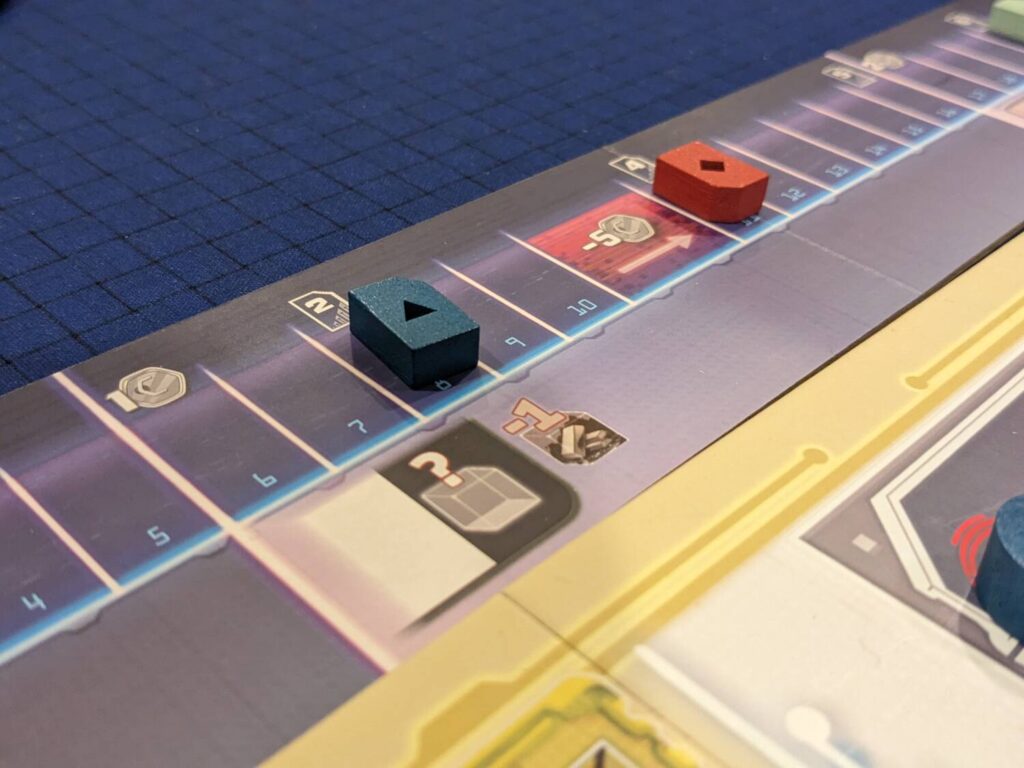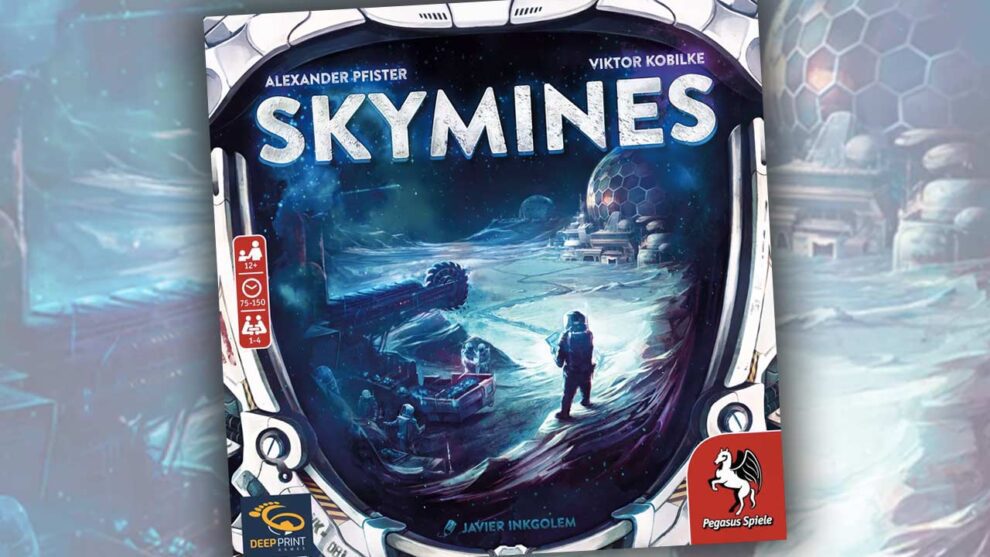Disclosure: Meeple Mountain received a free copy of this product in exchange for an honest, unbiased review. This review is not intended to be an endorsement.
There’s really no getting around it—the theme of Mombasa (2015, eggertspiele) is a little dicey, particularly for gamers who bristle at the idea that clever hand management mechanics have to go hand-in-hand with buying shares in companies trying to colonize parts of 18th-century Africa. My colleague Thomas Wells dove into some of these issues with his write-up on colonialism a few years ago.
So, designers Alexander Pfister (who designed the original game) and Viktor Kobilke took Mombasa and reimagined the game’s theme to a space race aimed at the pursuit of colonizing the moon.
Now we are left with an easier question: what if you took the same great gameplay from Mombasa, repackaged it with the space theme, and asked players for forgiveness that the first game’s theme was legitimately awful? We’re good, right?
Skymines (2022, Pegasus Spiele) plays it smart. This feels exactly like the original game, with all the great programming elements and tough decisions tied to a card recall mechanism that still feels wholly unique. Pfister and Kobilke added a second side of the main map to introduce a more complicated area majority system that affects the share prices of the four major corporations. There’s a solo mode now, a mode that is in the early lead for the best solo I’ve tried in 2024.
And you don’t have to feel ashamed any more when some of your gamer friends see Mombasa on your game shelf and begin to ask hard questions. I would argue that Skymines will let you toss the old game in the bin.

CrypCoin, You Say?
The base game version of Skymines and Mombasa—save for the theme—are the same games, mechanically.
Skymines is a 1-4 player, economic hand management game with an area majority mechanic that dictates the value of the game’s four corporations. These majorities play out on a map of the moon with about 25 different spaces. None of the corporations ever have a dedicated president, so all players have a chance to take actions on behalf of all corporations.
As investors, players attempt to back the most profitable companies colonizing the moon and earn the most CrypCoin, the currency of the future. Over the course of seven rounds, players will take turns trying to increase the coverage of corporations on the moon map, which slowly increases the value of each share players hold in that corporation.
These investors will gain shares through two means—moving up on tracks (it’s a Euro) and buying cards from a market, with some cards featuring shares printed on the bottom right-hand corner. Much like the best hand management games I played last year (Hegemony, Voidfall, Age of Industry), the heart of Skymines is the cards, with some offering valuable resources, company shares, or both.
At the beginning of the game, each player will have a hand of the same nine cards, showing small amounts of each of the game’s three resources (carbon, minerals, titanium) along with a research scientist and energy. Energy is used to expand a corporation’s presence on the map.
When play begins, three of these cards are seeded in individual slots along the top of each player’s personal board. The other six—mixed in with a seventh card aligned by player order—create both the starting hand and a difficult decision: which three of these cards will I play on my first turn?
That’s right—this is one of those programming games where you have to commit to playing cards and then hoping that your picks work out when all players reveal their choices. And as hard as that choice is, the real fun comes at the end of the round when you pick up one of your “resting decks” from above your player board to seed your hand for the following round.
At that moment, you have to place all played cards from the previous round into different individual slots above the player board. Each round, you are only getting one of those piles back. Sometimes, you will pick up cards from the market to play just once, never seeing them again during the game.
Mastering this puzzle feels like it could take a lifetime!

Two Out of Three
Skymines has one too many puzzles for me, much like Mombasa did.
You should play Skymines for the cardplay. It was brilliant when Mombasa was first released in 2015; it was still brilliant when I personally tried Mombasa in 2020, and it is still brilliant today. In fact, Skymines is another in a long line of reasons why I’m not drawing up my own game designs on weekends. I’m confident that even with the right amount of time, I could never come up with a game like this.
Each turn has a bunch of really cool decisions to make, thanks both to the cards and the timing considerations aligned with the face-up majority action spaces in the upper-right corner of the board.
You’ll use played cards in a current round to buy one of the 12 cards available in the market, a market that doesn’t refresh during the round. Without fail, the card you really want will be snatched up by another player who has bigger eyes and more vivid dreams than you do. No problem. I love that resource points used to buy cards could also be used to move up on the share tracks of any corporation. So there’s still value in the action if you get snaked by an opponent on the card you really wanted.
Cards that are bought are added to your hand to be played as soon as the next round. That’s key, because the real stress of the cards comes from picking up a resting deck once players have passed. Mombasa pros likely have this part down. I’m going to place this 2-Titanium card along with this 3-Energy card in the same pile, so that I can pick those up to play in the third round, so I’ll be ready to do X, then Y, then Z.
Even then: which cards do I spread out across the other piles? Each card has to sit in a different slot. This choice is hard when play begins, and then it just gets harder when other game effects open a fourth, then a fifth, action slot to play cards.
The burn is real, people!!
So, the card play of Skymines? Check. As a part of the cardplay, the race to snatch majorities plays into this so well. Because players can only claim action spaces based on the cards face-up at the bottom of their player board, each turn can become a stare down: do I take the energy majority spot now, to get a boost on share prices, or race to use those energy points to expand a corporation on the map, triggering instant bonuses of other types?
In a full player count game, going first can be so massive, and I like that players have to take a specific action to change that up.

The economic/area majority portion of the game is also excellent, and a bit like cube rails games such as Iberian Gauge or independent investor games like Dawn of Ulos and Acquire, it’s fun to mess with all corporations by expanding the ones you are most interested in, while also using actions to semi-sabotage corporations you don’t want to see getting ahead.
Diversification is key, both in life and in board game investment strategies, so it always pays to move up a little on all the tracks, not just one company that could be sabotaged by opponents later. So to keep things exciting, moving up on tracks feature game-breaking powers, keeping all players interested in at least considering having a few shares in all four corporations. (Oh, AND we get double-sided tracks that can be moved between different corporations from game to game? Yes, sir!)
So, check, check, when it comes to cardplay and the area majority mechanics. The difficulty for me with Mombasa’s tracks is the same as my difficulty with the player board tracks in Skymines: it feels like a bridge too far.
That is especially true with the unfortunately named tank track (tracked with a helium-3 marker, because, well, board games) on the left side of the player board. Advancing up this track isn’t easy, in part because you never get a big bump on this track early, even if you are trying. That’s because the starting hand doesn’t include the cards needed to move up on that track, cards referred to as Field Scientists. But getting to a certain spot on this track is important. Players begin with only three slots to use action cards, and moving up on the tank track grants the use of a fourth card slot, giving you more space to play cards in later rounds.
So, the tank track is important. It also scores a lot of end-game points, just like the research track sitting to the right of the tank track. But the tank track just isn’t much fun. It’s never interesting to go hard on the tank track. You move around, you get no additional bonuses for moving up on it, it weaves in a strange snake-like direction, and I’m not convinced that it is ever going to be a winning strategy. It just feels like more weight for the sake of more weight.
The research track, though? That’s quite interesting and has ended up being the most satisfying part of my Skymines plays. Players have to use research actions to acquire tiles that are laid out on the research track. But one can only advance on the research track by taking a research action, and the upload marker on the research track only moves over tiles that match the face-up cards currently on display in a player’s action area. That means that proper planning could lead to a massive jump on those tiles in a single action, so a highly strategic plan of attack can yield a couple of magical moments each game.
I didn’t remember loving this track when I played Mombasa (and that was only a single play), but I love the research track in Skymines. This puzzle, matched with the interaction on the moon map and in the card market, pairs nicely for those looking at their Eurogame experience as a partially heads-down affair. You have to pay attention to both, and the puzzle ends up being a fun way to pass the time between turns as you wait for your next go.

And That’s Just the Base Game
I’m really enjoying Skymines so far, and I haven’t once been tempted to try the second, more advanced map. (Skymines on its own is heavy enough!)
I am somewhat surprised to report that Skymines works at all player counts, although certainly it is most engaging at four. Solo is great, thanks to the AI module that doubles as an option to add more complexity/density to a two- or three-player game, similar to games like Oros. My first multiplayer game of Skymines was at two players, and I was surprised how much I enjoyed the head-to-head version of the game.
Scoring is a bit messy, with point totals reaching 150+ points with relative ease across four major scoring categories (CrypCoin, shares, tank track, research track). It’s not that the scoring is hard to track, it’s that the two tracks on the player board mixed with share value can make it a little hard to tell who’s in the lead from across the table. I think that is vital in an area majority game where you may want to target a player that has a sizable advantage.
The cardplay is excellent and I love how much competition exists on the map and on the action selection areas of the board. Skymines uses a bonus marker mechanic that means fights for share bumps tied to majorities of cards in play, or extra action tiles, is always fierce, more so in a four-player game.

The playtime really rises for higher player counts, and I don’t love the tank track. Also, the cards begin to feel a little stale almost immediately. I get why the choices are limited, and I still wish there was more variety in the cards. The game could use multi-resource cards, or a wider range of card costs, or high value resource cards, or something.
That means that the 2-resource cards that don’t have shares pre-printed almost always get passed over for better cards. Even players new to Skymines will notice this as an issue. Also, the graphic design here is somewhat misleading. Icons on the moon that show a mine also show a CrypCoin total nearby. Every player who tried Skymines wondered what the mine stood for. When I told them the truth—nothing—we all nodded in disappointment. Why duplicate something that is better illustrated by just getting to brass tacks? That space over there gives you money, period.
Ditto for the tank track…you get more points for moving up. But for reasons that I still can’t fathom, the decision was made to draw a series of spaces with point thresholds that can’t easily be followed in a snake-like pattern on the player board. This is the only thing about the game I would call legitimately “dumb”, but I was surprised how upset other players were with this track as well.
No game is perfect, and that trend continues with Skymines. Still, the original Mombasa design stands the test of time, and this updated version of the game will stick around in my collection for the long haul. Maracaibo is still my #1 Pfister game, but Skymines and Great Western Trail aren’t far behind.











